Smyrnium olusatrum
Smyrnium olusatrum, common name alexanders (or alisander) is an edible flowering plant of the family Apiaceae (Umbelliferae), which grows on waste ground and in hedges around the Mediterranean and Atlantic coastal regions of Europe. It was formerly widely grown as a pot herb, but is now appreciated mostly by foragers.
| Smyrnium olusatrum | |
|---|---|
 | |
| Scientific classification | |
| Kingdom: | Plantae |
| Clade: | Tracheophytes |
| Clade: | Angiosperms |
| Clade: | Eudicots |
| Clade: | Asterids |
| Order: | Apiales |
| Family: | Apiaceae |
| Genus: | Smyrnium |
| Species: | S. olusatrum |
| Binomial name | |
| Smyrnium olusatrum | |
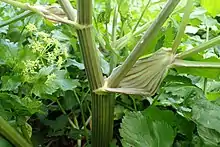
Description
Alexanders is a stout, glabrous (hairless) biennial growing to 150 (sometimes 180) cm tall, with a solid stem up to 22 mm in diameter, which becomes hollow and grooved with age. It has a tuberous tap-root which can be 60 cm long, as well as fibrous lateral roots.[1]
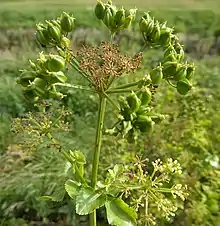
The stem leaves are arranged in a spiral (although the upper cauline ones are often opposite and sometimes in whorls of 3), with an inflated, purple-striped, fleshy petiole that has papery margins towards the base. The compound leaves are broadly diamond-shaped, 2- or 3-times ternately (sometimes pinnately) divided. Sometimes they are slightly hairy towards the base. The individual leaflets are dark green above, pale green below, flat, lobed and serrated with obtuse teeth that have a tiny white hydathode at the tip.[2][3]
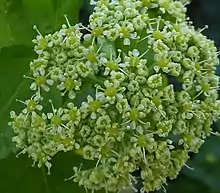
Inflorescences are terminal or in the leaf axils and consist of an umbel of umbels, 6-7 cm in diameter, with 5-25 rays which are glabrous, ridged and 2-4 cm long. There are 3-4 bracts which are small, pale and inconspicuous (or absent), and the peduncle is usually longer than the rays. The individual umblets are 10-20 mm across with 10-20 flowers and 1-5 tiny bracteoles. The actinomorphic flowers are small, with 5 yellowish petals and 5 tiny, green sepals, 5 stamens and (if present) 2 styles.
Sometimes there are 4 or 5 peduncles branching from the top of the stem, giving the impression of an umbel of umbels of umbels. Generally, it is only the terminal umbel that has 100% bisexual flowers; the lateral ones having both bisexual and male-only flowers (typically the male umbellules are in the centre); while the tertiary umbels often have only male flowers. This is best seen at maturity, when the male-only flowers wither without producing fruit.[1]

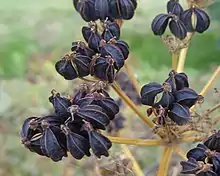
The mature fruit is a black schizocarp 6.5-8 mm long, which splits into two single-seeded mericarps, revealing a stalk (the carpophore) that runs between them. Each mericarp has 3 ridges and numerous vittae (oil tubes), which exude a pungent oil which smells of capsicum or diesel.[2] A single plant may produce between 3,000 and 9,000 seeds in a single year.[4][1]
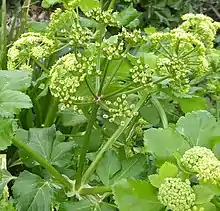
Taxonomy
Smyrnium olusatrum is in one of the numerous genera that are assigned to the subfamily Apoideae within the carrot family. The Apoideae are characterised by highly divided leaves, a lack of stipules, the compound umbels, the presence of a stylopodium, and fruit with a membranous endocarp and vittae.[4]
It was named by Linnaeus in 1753 in Species Plantarum (p. 262). Its name has remained unchanged since then, although the same plant has subsequently been given two other names (synonyms) which, as they came later, do not stand: Smyrnium maritimum Salisb. (1796) and Smyrnium vulgare Gray (1821). The plant was of course well known before Linnaeus's time but names pre-dating this are not used in botany (Linnaeus himself gave Hipposelinum theophrasti and Smyrnium dioscoridis as synonyms, citing Gaspard Bauhin's Pinax theatri botanici (1623)). A type specimen has subsequently been designated (lectotype), which is at the Natural History Museum in London.[5]
There are no named subspecies or varieties and it is not known to hybridise with any other species.[6]
Its chromosome number is 2n = 22.[4]
The generic name Smyrnium is derived from the Greek word for myrrh and the epithet olusatrum was the Roman name of a plant, from the Latin, olus = herb, and ater = black. The English name, alexanders, is a corruption of the Latin (olus ater ⇒ alisander) and does not have anything to do with Alexander the Great. There are numerous other vernacular names for it, including allsander, alshinder, alick, skit, skeet, hellroot (a corruption of "heal root"[7]), megweed, wild parsley, Macedonian parsley, wild celery, horse celery, stanmarch and black lovage.[8][1][9]
In Italy it is commonly known as macerone or maceronous corinol[10] (because it grows on rubble) and in Greece it is widely known as agrioselino (wild celery).[11]
In older botanical works, the planet symbol for Mars (♂) sometimes appears by the name.[12] This is simply a code to show that the plant is a biennial.[9]
Identification
There are few difficulties in recognising alexanders in northern Europe. Its compound ternate leaves are very distinctive, as are the yellow flowers. Amongst wild plants, it could possibly be confused with hemlock water-dropwort or wild celery but those species have white flowers. A commonly cultivated herb which does resemble it in its dark, shiny foliage is Lovage, but that has more sharply toothed leaves, no latex in the petiole, and a more erect habit.[3][13]
Distribution and status
Alexanders is widespread in Britain, where it is frequent in coastal areas in the south, becoming progressively rarer towards the north of Scotland.
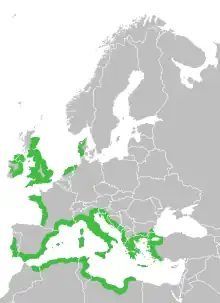
It does not occur in Orkney or Shetland.[14] It is a lowland plant, being recorded no higher than 290 m (in Cornwall).[15] Inland, it is often found close to the sites of medieval monastery gardens and other historical places such as castles.[16][17] In Ireland it is common around the south and east coasts, but rare inland and to the west.[18][1]
In Europe it occurs throughout the Mediterranean, where it is recorded in all coastal areas, including the islands, and it extends as far as Crimea and the Black Sea. It is also found along the Atlantic coast of the continent from the Iberian Peninsula northwards through France, Belgium, the Netherlands, Denmark and (recently) into Norway; and westwards to the Azores. In north Africa it is restricted to the Mediterranean and Atlantic regions, including the Canary Islands.
It is recorded as an introduction in New Zealand, Australia and Bermuda.[5][1]
The conservation status of alexanders in Britain is Least Concern,[19] and it is not considered to be threatened in any region, although it is rare in some countries, such as Belgium.[20]
Habitat and ecology
In Britain and the more northerly parts of Europe, the main habitat for alexanders is tall grassland, typically on road verges and woodland edges. It favours some soil disturbance initially, but once established it can be so dominant as to suppress most other plants. In the British National Vegetation Classification this habitat is described as a herb-rich type of MG1 false oat-grass community which, under other circumstances, would likely be dominated by cow parsley. A similar habitat occurs on the edges of scrub communities such as W21 hawthorn, W22 blackthorn or W24 bramble scrub.[21] It is common on waste ground and field margins, especially near the sea, where it may also be found on cliff paths and near the shore.[22]
It occurs on neutral to slightly calcareous damp soils which are moderately fertile, often in light shade. Although it is more common around the coast than inland, it has little tolerance for salt and its occurrence there may have more to do with milder temperatures found near the sea.[1]
Its Ellenberg values in Britain are L = 7, F = 5, R = 7, N = 7, and S = 0.[23]
It is a strictly lowland plant in northern Europe. In Britain, it is recorded no higher than 290 m, at Davidstow Airfield in Cornwall.[24]
In the Mediterranean, its habitat is similarly associated with patches of bare ground, but it is also likely to be found in phrygana, olive groves and orchards.[25]
The unspecialised flowers of alexanders are fragrant and are visited by a wide variety of insects. This is facilitated by the stylopodium, the bulbous base of umbellifer flowers, which secretes copious amounts of nectar that is easily available. In Britain, over 150 species have been recorded at the flowers, including many flies and bees, several beetles, butterflies and moths, and several other types of insect.[1]
Plants are often infected with "alexanders rust", Puccinia smyrnii Biv.-Bernh., which produces orange/yellow galls on both sides of the leaves and thickening of the stems, followed by dark brown telia on the undersides of the leaves only.[26]
There are at least nine species of insect which are found on alexanders in Britain and western Europe. Three produce leaf mines: the celery fly, Euleia heraclei (L., 1758), which creates dark patches on the leaf surface; a beetle, Orthochaetes insignis (Aube, 1863), whose larvae produce irregular tunnels; and another fly, Phytomyza smyrnii Spencer, 1954 (which has not been found in Britain but is known in Portugal), that creates linear mines.[27]
Other phytophages include the obscure beetle Liophloeus tessulatus (Müller, 1776), which apparently eats the roots and leaves. Three are aphids, Dysaphis apiifolia (Theobald), D. crataegi (Kaltenbach) (the hawthorn-carrot aphid) and D. lauberti (Borner, C.), which all suck the sap. The remaining two are micro-moths, Agonopterix heracliana (L.), whose larvae spin the leaves, and Udea prunalis (Denis & Schiffermüller), whose caterpillars feed on the leaves.[28]

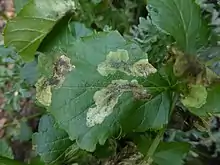
History
Alexanders is commonly supposed to be the herb described by Dioscorides as Hipposelinum, which the Romans called olusatrum. William Turner, writing in the late 16th century, explained how this was the accepted wisdom of his "masters", Antonius Musa, Fuchsius and Ruellius (referring to their herbals). However, after reading Dioscorides's De Materia Medica he realised that "our [i.e. English] Alexander is not Smyrniū in Dioscorides," because that species had paler leaves than parsley, a purplish colour, and a white root. Dioscorides himself had said as much, writing "Hipposelinum is different to that which is properly called smyrnium".[29][30] It therefore appears as if smyrnium and olusatrum were originally different plants which were confused, or conflated, by European herbalists.
This confusion only deepened in the following years. In the mid-17th century Nicholas Culpeper explained that "alisander... is sold in apothecaries' shops as Macedonian parsley-seed." However, he acknowledged that it was grown in "all the gardens in Europe, and so well known, that it needs no farther description."[31] John Ray explained in 1660 that alexanders was so called because in Italy and Germany it was known as herba alexandrina, having been supposed to have been brought from Alexandria.[1]
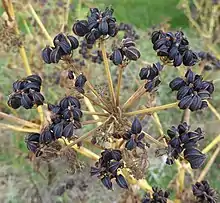
Alexanders (i.e. modern Smyrnium olusatrum) is often described as being native to the Mediterranean and only introduced further north,[16] but Randall points out that this is not based on any real evidence.[1] The earliest find of alexanders in Britain is a seed found at a Roman site at Caerwent.[32] This may be only because the pollen (which would normally provide palaeobotanical evidence) is difficult to identify. For this reason, and from the reading of Dioscorides, it is commonly said to have been introduced by the Romans.[33] Some authors, however, treat it as native.[34]
In Britain, the first record of alexanders as a living plant was by Turner in 1562. He wrote "Our Alexander groweth... in ilands compassed about the se between the far parte of Sommerset shere and Wales."[35] The site mentioned may have been Steep Holm, where John Lightfoot also saw it in 1773.[36][1]
Uses
Alexanders was once highly valued in northern Europe as an early vegetable: one of the few fresh plants that can be eaten in February or March. In the west of Britain, it had a reputation amongst sailors of "clearing the blood" and curing scurvy, and in Dorset it was known as "helrut", which is possibly a corruption of "heal root".[7] The seeds have also been used as a cure for scurvy.[37]
One 17th century text describes young shoots used in salads or a "vernal pottage" and an early 18th century recipe recorded by Caleb Threlkeld for Irish Lenten Potage includes alexanders, watercress and nettles.[16][38] In Turkey, where it is known as Baldiran or Göret, the young shoots and leaves are cooked and eaten with yoghurt, or eaten fresh as a salad, while the roots are also eaten, either cooked or fresh.[39] These are considered to be the best part, and are dug up during the winter, when the tubers are most fleshy, although foragers in Britain often overlook them, as it is illegal to uproot wild plants.[40] The young foliage is intermediate in flavor between celery and parsley and the seeds have an acrid, peppery taste.[41] It fell out of favour in the 18th century after celery started being mass produced to replace wild herbs and vegetables. It is not commonly used as a food product in the modern era,[16] but has found some renewed use in exotic "foraged" food recipes and restaurants.[42] It is also fed to livestock.[37]
Rev. John Skinner reported that bundles of alexanders stalks from Steep Holm were used for fuel in the 19th century.[43][1]
Although many authors claim that alexanders seeds smell of myrrh (presumably because of the name, Smyrnium) there are no documented reports of it being used as that. Studies have identified numerous aromatic compounds in various parts of the plant, but none is currently extracted for commercial purposes.[1]
References
- Randall, R.E. (2003). "Biological Flora of the British Isles: Smyrnium olusatrum L." Journal of Ecology. 91: 325–340. doi:10.1046/j.1365-2745.2003.00761.x. S2CID 85808284.
- Sell, Peter; Murrell, Gina (2009). Flora of Great Britain and Ireland, vol 3. Cambridge: Cambridge University Press.
- Poland, John; Clement, Eric (2009). The Vegetative Key to the British Flora. Southampton: John Poland. ISBN 978-0-9560144-0-5.
- Tutin, T.G. (1980). Umbellifers of the British Isles. London: Botanical Society of the British Isles.
- Global Biodiversity Information Facility. "Smyrnium olusatrum L." Retrieved 3 April 2022.
- Stace, C.A. (1975). Hybridization and the Flora of the British Isles. London: Academic Press. ISBN 0-12-661650-7.
- Allen, D.E.; Hatfield, Gabrielle (2004). Medicinal plants in folk tradition: an ethnobotany of Britain and Ireland (PDF). Portland, Oregon: Timber Press. ISBN 0-88192-638-8.
- Ravindran, P. N. (2017). The encyclopedia of herbs and spices. Wallingford, England: CAB International. p. 117. ISBN 9781780643151.
- Stearn, William T. (1980). Botanical Latin: History, Grammar, Syntax, Terminology and Vocabulary. Newton Abbot: David & Charles. ISBN 0-7153-5645-3.
- Bissante, Guidi (27 June 2017). "Un Mondo Ecosostenibile".
- VisitKythera.com (10 March 2020). "Wild celery (Alexanders)". Retrieved 6 April 2022.
- Leighton, W.A. (1841). A Flora of Shropshire. London: John van Voorst.
- Rose, Francis (2006). The Wild Flower Key. London: Frederick Warne.
- Preston, C.D.; Pearman, D.A.; Dines, T.D. (2002). New Atlas of the British and Irish Flora. Oxford: Oxford University Press.
- Pearman, D.A. "Altitudinal Limits of British Plants, 2021".
- Davidson, Alan, and Tom Jaine. The Oxford companion to food. Oxford University Press, USA, 2006. 805. Print.
- Lockton, Alex; Whild, Sarah (2015). The Flora and Vegetation of Shropshire. Montford Bridge: Shropshire Botanical Society.
- Scannell, M.P. and Synnott, D.M. 1972. Census Catalogue of the Flora of Ireland. Dublin Stationery Office.
- Cheffings, C.M.; Farrell, L. (2005). The Vascular Plant Red Data List for Great Britain. Peterborough: Joint Nature Conservation Committee.
- Verloove, F. "Manual of the alien plants of Belgium". Botanic Garden Meise, Belgium. Retrieved 8 November 2022.
- Rodwell, J.S. (1991–2000). British Plant Communities. Cambridge: Cambridge University Press.
- Hackney, P.(Ed) 1992 Stewart and Corry's Flora of the North-east of Ireland. Institute of Irish Studies The Queen's University of Belfast. ISBN 0-85389-446-9.
- Hill, M.O.; Mountford, J.O.; Roy, D.B.; Bunce, R.G.H. (1999). Ellenberg's indicator values for British plants. ECOFACT Volume 2. Technical Annex (PDF). Institute of Terrestrial Ecology. ISBN 1870393481. Retrieved 29 May 2017.
- Pearman, D.A. "Altitudinal Limits of British Plants, 2021".
- Warren, Susan. "Wild Flowers of Skopelos".
- Redfern, Margaret; Shirley, Peter (2002). "British Plant Galls". Field Studies. 10: 207–531.
- Pitkin, B.; Ellis, W.; Plant, C.; Edmunds, R. "SMYRNIUM. Alexanders. [Apiaceae]". The leaf and stem mines of British flies and other insects. Retrieved 9 November 2022.
- Biological Records Centre. "Insects and their food plants".
- Dioscorides P. "De Materia Medica" (PDF).
- Turner, William. "The Herball, or Generall Historie of Plantes". Retrieved 8 January 2022.
- Culpeper, Nicholas (1850). The Complete Herbal. London: Thomas Kelly.
- Lyell, A.H. (1911). "Appendix on the vegetable remains from Caerwent". Archaeologia. 62: 448.
- Sanderson, Helen; Renfrew, Jane M. (2005). Prance, Ghillean; Nesbitt, Mark (eds.). The Cultural History of Plants. Routledge. p. 113. ISBN 0415927463.
- Hanbury, F.J.; Marshall, E.S. (1899). Flora of Kent. London: Frederick J. Hanbury.
- Clarke, W.A. (1900). First Records of British Flowering Plants. London: West, Newman & Co.
- Riddelsdell, H.J. (1905). "Lightfoot's visit to Wales in 1733". Journal of Botany. 43: 290–307.
- French, D.H. (1971). "Ethnobotany of the Umbelliferae". In Heywood, V.H. (ed.). The Biology and Chemistry of the Umbelliferae. Academic Press. pp. 385–412. ISBN 0-12-346940-6.
- MM. Vilmorin-Andrieux; W.Robinson. 1885/undated. The vegetable garden: Illustrations, descriptions, and culture of the garden vegetables of cold and temperate climates, English Edition. Jeavons-Leler Press and Ten Speed Press. 1920 edition in Internet Archive
- Doğan, A.; Bulut, G.; Tuzlaci, E. (2014). "A review of edible plants on the Turkish Apiaceae species". Journal of the Faculty of Pharmacy of İstanbul Üniversity. 44: 251–262.
- Wright, John (2020). The Forager's Calendar. London: Profile Books. ISBN 978-1-78125-622-0.
- Down to Earth Bushcraft. "Alexanders". Retrieved 27 July 2022.
- Phillips, Roger (1983). Wild Food. London: Pan Books.
- Legg, R. (1993). Steep Holm Legends and History. Wincanton: Wincanton Press.
